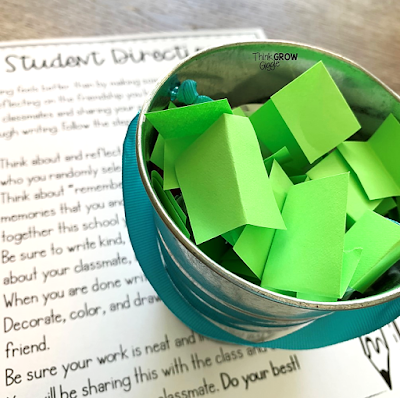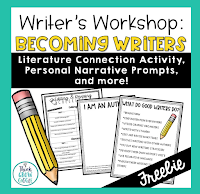There is nothing more important to plan for your students during the first few weeks of school, than your classroom community.
Building a strong classroom community takes thoughtful preparation and consistent implementation. A quick activity or two during the first few weeks of school is not enough to build a positive classroom environment. To build a classroom atmosphere where students feel safe to take risks and feel a sense of belonging takes many carefully planned activities and lessons, as well as the use of repeated language and clear expectations on a daily basis throughout the year.
Although the activities you create can vary year to year based on your students’ interests and needs, the 8 strategies in this post will help get you started building a safe and positive community in your classroom on the first day of school.
Grab this Community Building EXCLUSIVE FREE resource this week!
This is one you do not want to miss out on! These activities are perfect to build your classroom community starting on day one.
Be sure to read this post for ideas and strategies to use the free activities with your students so that they will:
- Be active listeners
- Participate regularly
- Enjoy learning
- Be part of a positive classroom environment
- And have fun the first week of school!
Sounds awesome right? Grab the free resource here, then keep reading!
Now on to these must-try 8 activities to start building a positive classroom community!
1. Have a Class Theme Song
I love having a class theme song each year! It is such an instant bonding activity, connecting all the students together. The class theme song is presented to the students with the concept that the lyrics and music would represent our class. Just as the instruments and lyrics come together to produce harmony in the song, all of the students can come together to create a class in harmony. We spend some time discussing what a class in perfect harmony would look and sound like.
There are two ways that I have selected theme songs with my students. For some years I have predetermined the theme song and then together as a class, we have analyzed the lyrics, discussing why it would be a good theme song. Then I let the students give me the final OK on the song that I selected. They always OK it and then instant buy-in! Other years, when my students were more mature to select an appropriate theme song, I allowed them each to come in with suggestions that would fit our classroom and the concept of a class in perfect harmony. Students submit ideas, anonymously, then the class votes to select one.
We play our theme song every day in one way or another: entry to the classroom, calm down after recess, during dismissal or just upon request. It is also a great go-to for background music for class videos or performances. The kids love to sing it together and it really connects us all!
2. Set Clear Classroom Rules and Expectations
We all know that classroom rules and expectations are a must, but be sure to not just slap your rules on the wall.
Take the time during the first day of school to create classroom rules together. The rules the kids come up with will usually always mirror the rules you have created. When students see the classroom expectations in their language they will have more buy-in and are more likely to follow them. Of course, throw in some clear language and expectations if the students need guidance.
I keep my classroom expectation list short. I like to make sure one of the expectations is “Use appropriate classroom behavior” as that one is the umbrella rule that covers just about everything. Other than that, let your students have a voice in what the classroom expectations should be! We also have a classroom pledge that we say each day during our morning meeting. We all love saying our pledge together. It is a great reminder of expectations and a reminder that we are in it together as a community. The pledge is posted in our classroom and after a few days, the children have it memorized. We can refer back to it during the day if anyone gets off track and needs a reminder of how we work and treat each other in our classroom.
Creating a class motto is another way to build classroom community and set clear expectations for your classroom.
3. Teach Students How to Be Active Listeners
Activities that foster active listening and communication are a must throughout the entire school year. These important skills are needed by the students not only for group and partner work in the classroom but anywhere they interact with others. Being a good listener can help with conflict resolution, especially during downtimes like recess and on the buses. Right from the start of the year, we discuss the ABCs of active listening and then put them into action with role-playing activities.
A simple way to practice these is to create a list of “problems” that the students have faced in the past (arguments over who won a game, copied an idea, or took someone’s supplies to name a few) and assign roles for each scenario. Students use the strategies discussed in the poster and our discussion to help them be active listeners and resolve the problem. With consistent practice and reinforcement of these steps, students will be active listening in no time!
4. Practice Effective Communication
Two activities that are fun and effective to do at the beginning of the year to illustrate how important communication is are the “Paperclip Challenge and “Draw It”. The concept of both is simple. One student creates a design without the other student seeing it and gives directions to help that student recreate that design. The student giving directions must give clear, specific, sequential directions to communicate effectively to help their partner, while the student listening to the directions must practice the all-important active listening skills that were discussed in class. Have each student take turns being the giver of directions and the receiver of directions.
5. Encourage Student Collaboration and Discourse
Working together collaboratively is a skill that must be taught, practiced, and monitored. No matter what grade you teach, students always benefit from the practice of taking turns speaking during a discussion. Once students have understood how important active listening and clear communication is, they are on their way to working collaboratively.
One strategy that always works well to encourage collaboration with my students each year is our “Two Cents” cups. It is really easy to make these cups, yet the value is immeasurable. Grab some cups, I use plastic or paper and attach the two cents labels. Explain the meaning behind the phrase “Put Your Two Cents In”.
In a nutshell, it means to share your opinion or thoughts. In the cup, place two pennies for each student in the group. (I use real pennies. I have found the plastic ones to bounce around when they fall on the ground. The kids take better care of the real pennies, too.) Each student grabs two pennies from the cup. Each time they contribute to the discussion or activity they place a penny in the cup. No student can share more than two times until each student has put “their two cents in”.
This works wonders for collaboration. It encourages participation from quiet students and keeps other students from taking over the conversation or work. As the year goes on, you will find most students don’t actually need the pennies anymore and instead, just use the language of “put your two cents in” to each other when they are working.
6. Foster Kindness in Your Classroom
Encouraging authentic acts of kindness in my classroom is a yearlong theme. It is also a great way for the students to build relationships with one another. Modeling kindness is key to getting your students to be kind themselves. Once my students understood our classroom community is based on kindness, I introduce our monthly Random Acts of Kindness Calendar. After I complete a September RAK calendar, I share it with the students, encouraging them to check the calendar each day with “suggested” ways to be kind.
As the month continues we check in on our progress during our morning meeting to see what acts of kindness were carried out and how it went. Before October begins, students work in pairs to create a RAK calendar. Each pair work on a calendar for a different month. When each pair of students are done, we have a yearlong RAK calendar to display and carry out in our classroom. The kids always love creating the calendars and looked forward to seeing each month’s ideas. Scoop up this calendar set for FREE HERE.
7. Complete Monthly Community Building Activities
As the year rolls on, we continue to build our classroom community with positivity and strengthen student relationships in authentic ways.
Sometimes a little reminder of how to make someone smile is in order, too! Each month we dedicate one writing period to making someone’s day a little brighter. Names are randomly drawn from a bowl and students write letters, poems or create illustrations about one of their classmates. This small gesture helps the creator feel good about making someone else’s day better and the receiver feel appreciated and part of our classroom community. Towards the end of the period, a student is selected to share what they wrote and deliver it to the receiver. Then the receiver shares their letter until all letters are shared. This simple monthly activity is a great way for each and every student to feel a sense of belonging and a valued member of our community. It is a great self-esteem builder, too! Students beam so brightly when they receive these little letters of appreciation.
8. Have High Expectations
An easy way to do have students maintain classroom expectations and relationships with you are away is by using a mystery surprise. Grab a mini whiteboard and add ten dashes. Each time the students get a compliment from a special area teacher, add a letter to build-up to the words: We Did It! When all the letters are filled in, the students can earn any surprise you want. Easy, no-cost prizes could include extra recess, no homework, game time (a simple game of hangman with class vocabulary words is always fun!) or sit next to your friend day. This is also a great motivator for students when there will be a sub or guest teacher in your classroom. By offering this small and simple incentive, students truly have to work together to earn it, strengthening the relationships that you are nurturing.
Remember that building relationships, setting classroom expectations, and consistently nurturing these expectations throughout the school year is the best way to create, build and maintain a positive classroom environment. It is well worth the time and energy that you put into it! The outcome is a positive place where students want to be and work each and every day!




































